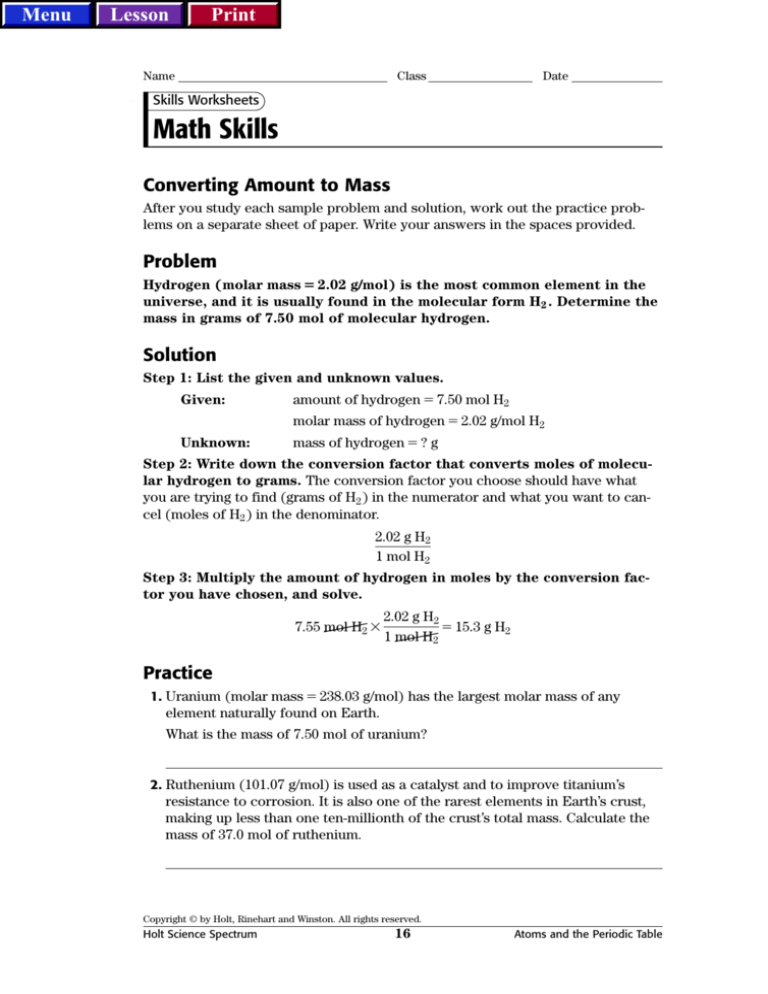
Menu
Lesson
Print
Name
Class
Date
Skills Worksheets
Math Skills
Converting Amount to Mass
After you study each sample problem and solution, work out the practice problems on a separate sheet of paper. Write your answers in the spaces provided.
Problem
Hydrogen (molar mass 2.02 g/mol) is the most common element in the
universe, and it is usually found in the molecular form H2 . Determine the
mass in grams of 7.50 mol of molecular hydrogen.
Solution
Step 1: List the given and unknown values.
Given:
amount of hydrogen 7.50 mol H2
molar mass of hydrogen 2.02 g/mol H2
Unknown:
mass of hydrogen ? g
Step 2: Write down the conversion factor that converts moles of molecular hydrogen to grams. The conversion factor you choose should have what
you are trying to find (grams of H2 ) in the numerator and what you want to cancel (moles of H2 ) in the denominator.
2.02 g H2
1 mol H2
Step 3: Multiply the amount of hydrogen in moles by the conversion factor you have chosen, and solve.
7.55 mol H2 2.02 g H2
15.3 g H2
1 mol H2
Practice
1. Uranium (molar mass 238.03 g/mol) has the largest molar mass of any
element naturally found on Earth.
What is the mass of 7.50 mol of uranium?
2. Ruthenium (101.07 g/mol) is used as a catalyst and to improve titanium’s
resistance to corrosion. It is also one of the rarest elements in Earth’s crust,
making up less than one ten-millionth of the crust’s total mass. Calculate the
mass of 37.0 mol of ruthenium.
Copyright © by Holt, Rinehart and Winston. All rights reserved.
Holt Science Spectrum
16
Atoms and the Periodic Table
Menu
Lesson
Print
Name
Class
Date
Math Skills continued
3. Large deposits of manganese (54.94 g/mol), a metal used to form many different types of alloys, have been found on the floors of oceans and large lakes.
Suppose one of these deposits contains 383 mol of manganese. What is the
mass of the manganese deposit?
4. Sodium chloride (58.44 g/mol), commonly known as table salt, is the most
common type of salt. What is the mass of 29.0 mol of sodium chloride?
5. Oxygen gas is most often found as O2 (molar mass 32.00 g/mol).
However, under certain conditions, a compound called ozone, O3
(molar mass 48.00 g/mol), is formed. Ozone, which is highly reactive and
unstable, is formed when O2 is exposed to ultraviolet radiation. Ozone is able
to absorb other ultraviolet radiation, protecting life on Earth’s surface from
this harmful radiation.
a. What is the mass of 17 mol of O2 ?
b. What is the mass of 17 mol of O3 ?
6. After oxygen, silicon is the most common element found in Earth’s crust.
Both elements are found in silicon dioxide (molar mass 60.09 g/mol), which
is the main component in sand. Suppose you have 893 mol of silicon dioxide
in a sample of sand. What is the mass of the silicon dioxide?
7. Carbon dioxide (molar mass 44.01 g/mol) is an inert gas that plants need for
photosynthesis.
a. Calculate the mass of 893 mol of carbon dioxide.
b. How does the mass you obtained in part (a) compare with the mass of
893 mol of silicon dioxide?
8. Both marble and limestone contain the same mineral, calcite, which consists of
the compound calcium carbonate (molar mass 100.09 g/mol). What is the
mass of a block of calcite if it contains 37 mol of calcium carbonate?
Copyright © by Holt, Rinehart and Winston. All rights reserved.
Holt Science Spectrum
17
Atoms and the Periodic Table
Menu
Lesson
Print
TEACHER RESOURCE PAGE
11.
number
of boxes
number of
number of bulbs
chandeliers
per chandelier
number of
bulbs per box
number
of boxes
gU
1790 g U
238.03
1 mol U 101.07 g Ru
2. 37 mol Ru 1 mol Ru 1. 7.50 mol U (75 chandeliers) 12 bulbs/
chandelier
(4 bulbs/box)
225 boxes
total sodium
total sea12.
chloride mass
water mass
CONVERTING AMOUNT TO MASS
mass sodium
chloride per
kilogram sea water
3.
4.
5.
(7.400 106 kg seawater)
26.84 g sodium chloride
1.000 kg sea water
6.
total sodium
chloride mass
1.986 108 g sodium chloride
5
1.986 10 kg
7.
60 min 60 s
3600 s
hour
min
60 s
45 min 2700 s
min
total time 6300 s
film length (total time)
13. 1 hour 8.
CONVERTING MASS TO AMOUNT
1 mol Au
0.41 mol Au
196.97
g Au
1 mol Au
4.0 g Au 196.97 g Au
1. 81 g Au per
length per
frames
second
frame film length (6300 s)
(24 frames/s)(1.9 cm/frame)
film length 2.9 105 cm
2.9 103 m 2.9 km
total
14.
volume
number of
volume per
columns
column
total
(46 columns)
volume
(3.14)(0.95 m)2(10.4 m)
total
1.4 103 m3
volume
3.8 103 g Ru
54.94 g Mn
383 mol Mn 1 mol Mn
2.10 104 g Mn
58.44 g NaCl
29.0 mol NaCl 1 mol NaCl
1.69 103 g NaCl
32.00 g O2
a. 17 mol O2 1 mol O2
5.4 102 g O2
48.00 g O3
b. 17 mol O3 1 mol O3
8.2 102 g O3
60.09 g SiO2
893 mol SiO2 1 mol SiO2
5.4 104 g SiO2
44.01 g CO2
a. 893 mol CO2 1 mol CO2
3.9 104 g CO2
b. Mass of CO2 is less.
100.09 g CaCO3
37 mol CaCO3 1 mol CaCO3
3.7 103 g CaCO3
2.0 102 mol Au
1 mol Al
3.08 mol Al
2. 83.2 g Al 26.98 g Al
1 mol Al
1.51 105 g Al 26.98 g Al
5.60 103 mol Al
1 mol Os
3. 22.6 g Os 190.23 g Os
0.119 mol Os
1 mol Ir
22.6 g Ir 0.118 mol Ir
192.22 g Ir
Copyright © by Holt, Rinehart and Winston. All rights reserved.
Holt Science Spectrum
96
Atoms and the Periodic Table









